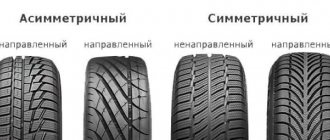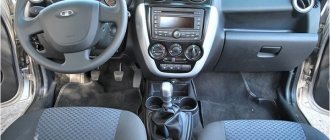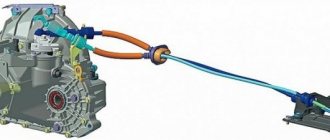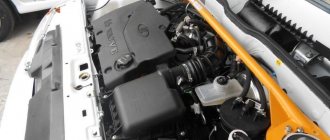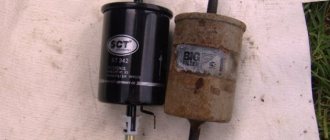05 December 2014 Lada.Online 123 087 8
An experienced driver knows how important it is to periodically check the pressure in your car's tires. If the pressure does not correspond to the recommended one, this leads to accelerated tire wear, as well as a deterioration in the stability and controllability of the vehicle. The table shows the recommended tire pressure for the Lada Granta.
What does air pressure in tires affect?
The pressure in car tires determines the level of driving comfort and safety, and also contributes to the durability of the working units and components of the car.
Low pressure in Lada Granta tires increases heating during rolling and contributes to wear of the tread tracks located along the edges. The integrity of the frame may even be compromised. Fuel consumption also increases. If you hit a pothole, the risk of damage to your rim or tire is much higher.
Tire pressure "Lada Grants"
Increased tire pressure on the Lada Granta overstrains the cord threads and wears out the middle section of the tread. In addition, when driving on a bad road, the shocks transmitted to the suspension and body will be more clearly felt by passengers. Of course, the suspension will also wear out more. And if you drive into a pit, the risk of a tire rupture increases.
Different pressure for all four wheels also has its drawback: in this situation, when braking, the car is guaranteed to be pulled to the side by the wheels with minimal pressure, and the car will actually start moving sideways.
Tire life
Reduced tire pressure on the Lada Granta increases tire abrasion at the edges.
Increased - also affects the service life of tires. In this case, the tension in the carcass threads increases: as a result, the cord breaks down noticeably faster. In this case, the tire interacts with the road through the middle section of the tread, which provokes its rapid wear.
Compliance with the recommended pressure allows you to evenly distribute the load and increase the tire life.
Machine controllability
The pressure of a specific value in the Lada Granta wheels is indicated for a reason. Although its reduced performance at low speeds does not particularly affect the car’s behavior, at speeds of 60 km/h or more, underinflated tires significantly worsen handling and increase braking distance.
A car with increased pressure in the tires on a dry road surface is somewhat better in handling, however, strong overinflation of the wheels leads to the fact that any sudden maneuver guarantees a skid (especially on a wet road), or even a complete loss of control.
With reduced pressure in the Granta wheels, the car’s ability to turn also changes. for example, a rear-wheel drive car with lowered front tires will have a harder time turning.
The inflation of the front wheels of a front-wheel drive car must always be normal, since its reduced level provokes skidding in an emergency situation.
P14 wheels on Grant
Patency
Even the owner of an ordinary four-wheel drive car, for example a sedan, can independently provide it with tolerable cross-country ability. To do this, just let some air out of the wheels, and they will not sag in sand, snow or mud. To even get out of a “black spot”, you just need to lower the pressure to 1.2 bar.
In a particularly difficult situation, if your wheels have a narrowed rim and a fairly wide tire (in this combination there is a lower risk of self-disassembly), the indicator can be increased to 1.0 bar.
Stability on slippery roads
A wet track always carries danger. But if you increase the pressure in the Lada Granta tires, reducing the contact patch of the rubber with the track, the risk of aquaplaning will also decrease. This will also improve handling and optimize fuel consumption. However, you need to know when to stop, as this option has its own disadvantage: an increased risk of a tire explosion.
If the car slips on wet grass, then, on the contrary, relieve the pressure.
Braking efficiency
The higher the pressure in the Grant R14 wheels, the less grip they have on the road. Consequently, the longer the braking distance: as the atmosphere decreases, it will decrease, but at the expense of reduced directional stability.
What tire sizes does the manufacturer recommend to install?
The manufacturers of the Lada Kalina car tried to work on the technical part, so now the consumer receives a wide range of options and offers.
There are three options for car tires:
- The standard “Zhigulevsky” version is car tires size 175/70R13. This is a classic that will always be in fashion due to the combination of its attractiveness, practicality and technical features.
- The second option is more suitable for VAZ cars - 175/65R14, and such tires are very often found on Lada Kalina, since this emphasizes sophistication and sophistication.
- The third standard tire option for Lada Kalina cars is 185/65R15.
All other tire options cannot be called standard, so they are not always suitable for Lada cars, as they combine some inconveniences for subsequent use. An important point is that the Lada car does not always tolerate experiments, so it is better to use the classics. But there are also certain non-standard options that have a right to exist.
What should be the pressure in Grant tires under different conditions?
For every 10 degree change in temperature, the air pressure in the tire also changes by 0.1 bar. So, if in summer the indicator should be 1.9-2.0 atmospheres, then in winter or at full load it reaches 2.1-2.2, and cars with summer tires in April, they can only be pumped up occasionally until the beginning of September. But the winter one will have to be checked regularly after the next frost.
In summer
In the summer, during extreme heat, the pressure in the p14 wheels on the Grant increases slightly due to the heating of the air in the tires. So you don’t have to pump them up, plus or minus 0.3 atm.
in winter
In winter, the air is compressed, which is why the tires need to be pumped to the same 0.3 atmospheres: even if in a warm garage the pressure gauge shows the desired value, on the street the value will drop by at least 0.3 bar, and you will find yourself with underinflated tires.
Installing a pressure gauge to check tire pressure
For a relaxing ride
In Lada Granta wheels, the pressure should be standard for quiet driving, that is, recommended. Car manufacturers place the “cheat sheet” on the gas tank cap, the middle pillar or on the driver’s side door. As a rule, you can use tires of different sizes, and the required value for them is not always the same.
For racing
In motorsports, everything is determined by the contact patch of the tire. By increasing or decreasing it, it is easy to change the handling of the sports car.
By reducing the pressure in the wheels of the Lada Granta liftback, we increase the contact area. If you increase the pressure, the car then responds better to the steering impulse, and straight line acceleration increases due to reduced rolling resistance.
But the traction properties of the tire will also become less: overinflated wheels seem to stand on tiptoes. So, depending on the requirements of your type of motorsport, you need to find a compromise so that the tires have enough grip during acceleration and braking, but do not deform when cornering due to low inflation.
For long trips
When traveling long distances, it is recommended to lower the tire pressure by 0.1 atmospheres. Long driving easily compensates for this decrease by heating the air, which expands as a result.
For driving in mud
When you find yourself on a muddy dirt road, it is better to lower the wheels: the contact area will increase, the ride will become more comfortable, and the suspension will not wear out.
For driving in open mud, it is better to reduce the pressure to 1 bar. Just remember that in this case you should not accelerate over 30 km/h. Otherwise you risk losing control. It is also undesirable to let the tires go down too much before descending a steep slope, since during braking the tires will rotate independently even after the wheel rims are locked.
For driving on snow and ice
If ice catches you by surprise, it is better to lower your wheels to 1.5 atm. Tire wear will, of course, increase, but cross-country ability will also increase significantly. However, in this case, any high speed is unlikely, and overheating of the rubber at low temperatures most likely will not occur.
Forcing deep snow also means reducing pressure: this way you will noticeably increase the contact area, and, on the contrary, minimize the pressure on the snow.
The main thing is not to overdo it. To avoid getting stuck in the snow, it is recommended to inflate tires to 0.8–1 atm. But if you have low-profile ones, it is better not to drop below 1.2 atm.
"Lada Granta"
Please note that even a short trip on lowered wheels heats up the air in them and increases the pressure.
For transportation of goods
It is advisable to take into account the manufacturer's advice on tire pressure when fully loaded. At a minimum, you should inflate the wheels at least at the rear by 0.2–0.3 bar.
Sphere of influence of tires and wheels
Parameters and technical characteristics of the Lada Granta.
Lada Granta VAZ 219010. Lada Granta model 219010 The answer to the question regarding the equipment of the Lada Kalina: which wheels are suitable can be found in the manufacturer's instructions. The factory documentation for Lada Kalina indicates three types of tires recommended for installation:
- one of the popular options, also installed on classics, is 175/70R13 tires;
- the most common tire size today is 175/65R14;
- another standard option is 185/65R15.
The plant also allows the Lada Kalina to be equipped with 185/60R14 and 185/55 R15 tires.
What size tires are Lada Kalina Cross? It is recommended to install tires with overall dimensions of 195/55R15 on this model.
For the Lada Kalina Sport car, the factory has established its own standards:
- 185/55R15 or 195/50R15;
- 195/50R16;
- 205/40R17.
To understand which tires are best suited for the Lada Granta, you first need to find out what the size of the tires and wheels of the car affects. Service station specialists note that when replacing tires, one should be guided by the fact that the difference in outer diameter is minimal.
The selection of tires affects the following features of vehicle operation:
- brake and traction characteristics;
- transmission;
- fuel consumption;
- atmospheric emissions.
| Tire increase | Disc enlargement | Wheel enlargement | |
| Steering precision | |||
| Tire grip on wet roads | |||
| Tire grip on dry roads | |||
| General driving comfort | — | — | — |
| Fuel consumption | |||
| Wear rate | |||
| General management indicators |
Symbols: - improvement, - - deterioration, 0 - no change.
Changing your tire size will definitely lead to changes in your vehicle's handling accuracy. As the volume of the tire becomes larger, the scale of the space in contact with the road surface increases. This provides ample opportunities for maneuverability.
According to the factory specifications, the original tires supplied from the factory have a radius of R14 and R13. R14 is a fairly classic option for small cars. Both wheels and tires with these dimensional characteristics are inexpensive and are quite easy to find on the market. The situation is similar with the R13. Therefore, when analyzing which discs are suitable for the nagrant, you should keep this point in mind.
Size characteristics of tires and wheels, which are also suitable for LadaGranta Currently, all AvtoVAZ models with front-wheel drive are equipped with R15 size wheels. And although the original Lada Granta R15 tires with this wheel model have dimensional characteristics of 185/55, they will also fit well with tires 175/70, 185/60 and even 195/55.
Lada Granta Sport tires have a factory size of R16. The dimensions of the tire itself are 195/50. On the Grant Sport, the tire size dictates that the rack is shortened, allowing even the smallest wheel to fit into the space for it. With this wheel diameter you can safely install tires of sizes 175/50, 184/45 and even 195/40.
Tires for winter use must have soft contact with the road surface, which will provide a reliable degree of traction even on packed snow, and the tread base must be rigid for precise steering. Goodyear, Pirelli and Dinlop Winter companies have the necessary dimensional characteristics for the Lada Granta, namely in the range from R13 to R16.
Winter tires will also require running-in to ensure they fit firmly in their seats. For a good break-in, you will need to drive about 500 kilometers. When running in, you should try to avoid sudden braking and slipping. To improve traction, it is also recommended to choose tires with a narrow profile.
How to determine tire pressure
Tires should be checked regularly: before a trip or once a week. Measure the pressure when the tires are cold, that is, several hours (4-5) after stopping the car. If pumping is required on the way, it is better to make it 10% more than normal. Verification can be carried out in different ways, which we will discuss further.
Compressor
A compressor is a special machine for inflating tires. Connect it to the mains and watch the built-in pressure gauge. When the pressure rises to the desired level, the device will simply turn off.
Pressure gauge
Using the pressure gauge is extremely simple:
- You need to remove the cap on a car tire.
- Apply the pressure gauge to the valve for a few seconds.
- Compare the performance of all four tires and, if necessary, inflate.
The entire procedure takes a maximum of a few minutes.
Sensors
The sensors convert the pressure information received from the wheel controllers into an electrical signal and transmit it to the transceiver via Bluetooth. A special program processes this data and, if necessary, signals the driver. Some systems send a message to a smartphone.
You can set the limit values of operating parameters yourself: adjustment is available from 1.7 to 3.2 bar.
Visually
It is better to carry out an inspection before each trip: at least just to see if there are any flat tires. But it is not possible to determine the pressure “by eye”: even 10 PSI and 20 PSI are practically indistinguishable in this way.
Handheld portable pressure gauge for checking tire pressure
Only a high-quality pressure gauge guarantees you an accurate result.
Is it worth it or not to inflate your tires with nitrogen?
Recently, almost all tire stations have introduced the expensive service of filling tires with nitrogen. Its popularity is due to a number of the following opinions:
- Thanks to nitrogen, the pressure in the tires remains unchanged when they heat up.
- The service life of rubber increases (it practically does not “age”, since nitrogen is much cleaner than air).
- Steel wheel rims are not subject to corrosion.
- The possibility of tire rupture is completely eliminated, since nitrogen is a non-flammable gas.
However, these statements are nothing more than another advertising ploy by marketers. After all, the nitrogen content in the air is about 80%, and it is unlikely that anything can change for the better if the nitrogen content inside the tires increases by 10-15%.
In this case, you should not spend extra money and inflate the wheels with expensive nitrogen, since there will be no additional benefit, as well as harm, from this procedure.
https://youtube.com/watch?v=QVBHaJw2t28
Not every driver pays attention to the pressure in the tires of his car. But safety on the road, controllability and maneuvering of the car sometimes depend on the pressure in the tires.
In addition, the level of tire pressure affects:
- on fuel consumption,
- uniform wear of the wheel itself,
- may cause hernias on the wheel court.
If the pressure in tires r13 and r14 is increased, then, for example, when hitting an obstacle, the tire may even explode. Incorrect tire pressure r15 will also affect maneuverability when cornering, turning, etc. The following figure will best show the different levels of inflation of car wheels.
Tire pressure
As you can see, just by the wear of the tread you can determine what the problem is with inflating the rim, but it is better not to let it get to that point, but to maintain a certain atmosphere at the required values.
Tire pressure must be checked at least once a month. Professional drivers check every 2 weeks and before each long trip. And an external inspection of the wheels should be done daily before starting the car engine. Although if you are the happy owner of low-profile tires, then it is impossible to determine what pressure should be in the tires by eye.
Is it possible to drive on flat tires?
Driving with flat tires is, of course, possible, but it is fraught with consequences.
This results:
- to wipe the side protectors;
- excessive heating of rubber and its accelerated deterioration;
- deterioration of vehicle controllability, especially when cornering;
- excessively high fuel consumption.
The only advantages of underinflated tires are a soft ride, and also the fact that there is no noise or rattling. However, the disadvantages of such use clearly outweigh the advantages.
Is it possible to drive on overinflated tires?
Of course, you can ride with such tires, but if you do it too often, you cannot avoid the consequences:
- the suspension quickly fails;
- the middle section of the tread is wiped off;
- The interior rattles, and you can especially feel the bumps on the road.
The only plus is fuel economy.
Review of the best summer and winter tires for Lada Granta
"Lada Granta": ground clearance. "Lada Granta": technical characteristics of the car
The most popular winter tires:
- Vredestein Wintrac Xtreme S - the tread consists of Velcro, which provides maximum traction on wet asphalt and loose snow. The maximum temperature of use is 25°C. The critical point is -35°. The average cost in online catalogs is from 8,500 rubles.
- Goodyear UltraGrip Performance Gen-1 - balanced price-quality ratio. The tire provides good traction on loose snow and ice at sub-zero temperatures. Average price from 7,000 rubles.
- Dunlop Winter Sport 5 is a soft compound rubber that is not susceptible to hardening when the temperature drops. The price of one tire is from 5,500 rubles.
- Pirelli Winter Sottozero 3 is a popular model among car enthusiasts in the CIS, including the Russian Federation. Good quality, technical specifications at an affordable price. The service life before replacement exceeds 60 - 70 thousand km. mileage The average price by region is from 5,000 rubles.
- Nokian WR D4 is an economical option for most car owners. High-quality grip, long service life, affordable price from 2900 rubles.
Summer tires for Lada Granta:
- Goodyear Ecient is a high-quality tire at a premium price from a European manufacturer. The tire warms up within a few seconds, providing the widest possible contact patch with the road surface. Rubber guarantees grip, control, cornering, and a minimum percentage of skidding at medium and high speeds. Average price from 5000 rubles.
- Grip Performance is a budget option from a European brand. Better than standard tires in terms of technical characteristics, acceptable for use in urban conditions. Price from 5500 rubles.
- Hankook Ventus Prime3 K125 is also a budget model with a price starting from 6,000 rubles. Above average quality at an affordable price.
- Dunlop SP Sport MAXX RT2 is a tire with unidirectional tread, which ensures high handling and minimal vehicle roll when cornering, regardless of weather conditions and temperature conditions. Average cost from 5200 rubles.
- Dunlop SP Sport MAXX RT - tires are similar to the previous ones, except that the tread pattern is asymmetrical. Price from 5100 rubles.
- Pirelli P7 Cinturato Blue - long service life is the main highlight of the rubber. The average service life exceeds 65,000 km before replacement. Average price from 5500 rubles.
Service station specialists strongly recommend changing tires strictly according to the seasons, and to a lesser extent using universal, all-season tires. The operating temperature range is several degrees lower than seasonal tires, resulting in reduced vehicle controllability.
Indexes and markings of tires on Lada Granta
To choose the right tire you need to be able to read the indices and other symbols on the tires, namely:
- “T” - the maximum permitted speed of movement is not more than 195 km / h. “H” - up to 205 - 210 km/h. It is not recommended to exceed the speed range, as there is a high probability of shooting, cord deformation, and, as a result, an emergency;
- “Q” - load capacity index: from 85 to 490 kg;
- “ET” is the metal rim bead extension coefficient;
- “KM” - partial and full load index: no more than three passengers, cargo in the trunk up to 50 kg;
- “M+S” - full load - more than three people and over 50 kg in the trunk.
What does the pressure in Lada Granta tires affect?
- Safety and comfort when traveling by car. Over-inflated tires become hard and produce a distinct knocking sound when they hit a hole or bump. There is a high probability that the metal rim will be deformed and the camber-toe angle will be disrupted.
- Fuel consumption: the lower the pressure, the more effort the engine needs to put in to rotate the wheel and move the car. In the case of overinflated tires, fuel consumption is within normal limits.
- Chassis and suspension of the vehicle: overinflated tires do not dampen impacts from unevenness and potholes, but fully transfer them to steering rods, ends, and ball joints. Thus, the elements of the steering system fail faster.
- Shock absorbers and strut pressure springs: similar to the steering rack, rods, and tips, the elements wear out faster due to systematic work. Sharp jolts and impacts cause the spring coils to burst, become deformed, and the shock absorber rod breaks the cylinder.
If you encounter any difficulties with repairs or diagnostics of components and assemblies, contact specialists from service stations, workshops, and service centers for help.
Source
How to pump up tires
You need to pump up the Lada Granta wheels according to the following scheme:
- Find out the recommended pressure.
- Check the level in the wheel.
- If the indicator is more than necessary, bleed off the excess: use a fingernail or something pointed to press the central pin of the nipple.
- If the indicator is less than required, then inflate the tire with a pump or compressor.
- Screw the nipple cap into place.
Tire pressure "Lada Grants": checking with a pressure gauge
Carry out this procedure for all tires.
Features of Kalina tires
Need reliable tires for your car?
Maintaining the correct tire pressure reduces gas mileage and improves vehicle stability in adverse weather conditions.
When monitoring the normal indicator, it is important to consider that the pressure should be the same in all tires, including the spare
On cars such as Lada Kalina, the pressure should always be within 2 atm. with the exception of the cold season. In this case, you need to focus on the outside temperature, because it affects the amount of air in the wheels.
If your Kalina has standard tires, then they are tubeless. Such tires are installed on almost all modern cars; they require special pressure monitoring. It is necessary to constantly monitor the presence of cracks and bumps on the surface of the wheels. Otherwise, there is a possibility of running into an object with a sharp angle, which will cause a tire puncture due to increased pressure in it.
What to do if the tire keeps getting flat
Most often, tires leak air due to damage. But even if you find the problem area yourself, it is best to replace the flat tire and take it to a tire shop for diagnosis and repair. Sealant for car tires will only give a temporary effect.
If the tire goes flat not because of damaged tires, then there are only two options:
If your disk is deformed after hitting a hole or bump at speed, then the tire is no longer able to fit it tightly. The situation can be corrected either by purchasing a new disk or by restoring the geometry of the old one. Sometimes the rubber does not adhere to the disc due to corrosion - in such a situation it is better to get rid of it immediately.
Problems with the spool can be solved quickly and easily by simply replacing this “penny” part.
!TIRE PRESSURE using the example of Lada Granta 2020
Source
Video - New LS wheels and Pirelli tires on Grant
Car wheels are an integral and one of the most important parts of any vehicle. The Lada Granta model is suitable for several sizes of wheels and tires, which the manufacturer installs depending on the overall design of the car.
The most frequently produced Grant models are cars with stamped wheels with diameters R13 and R14. Relatively recently, the size range has expanded with R15 and R16 wheels.
ATTENTION! A completely simple way to reduce fuel consumption has been found! Don't believe me? An auto mechanic with 15 years of experience also didn’t believe it until he tried it. And now he saves 35,000 rubles a year on gasoline! Read more"
The size of the wheels and tires significantly affects the overall performance and behavior of the car on the road. Therefore, the manufacturer does not recommend installing wheels on the LADA Granta whose rim diameter exceeds R15. Owners of cars of this model come to the same opinion. When surveying car enthusiasts, it was revealed that most drivers use wheels with a diameter of 15.
According to technical specifications, factory-equipped vehicles may have the following tire sizes:
Thus, the most suitable tires for a car of this model are R13 and R14 tires. This is a classic size for the Russian car manufacturer. These tires are easy to find on the market. Another advantage is their affordable price.
The possibility of installing R15 tires on the Grant is not excluded. When leaving the assembly line, a car with a rim diameter of 15 has a tire size of 185/55. However, they will fit well with tires from the 175/70 or 185/60 size range.
The difference in the size of the wheels and tires for them affects a number of indicators - the appearance of the car, its behavior while driving, handling, road grip, ride comfort, noise indicators, fuel consumption, tire wear resistance. Therefore, when choosing the size of tires and wheels, you should first familiarize yourself with the table below, where “+” is an improvement, “0” is no change, “-” is deterioration, “>” is an increase.
| Index | Increased disc diameter | Increased rim width | Increased tire width |
| Car appearance | + | + | + |
| Road grip | + | ||
| Controllability | + | + | + |
| Comfort on difficult roads | — | — | |
| Fuel consumption | > | ||
| Noise indicator | > | ||
| Wear resistance | — | ||
| Car behavior while driving | + | + | + |
Factors to consider
Firstly, it is safety. It is not for nothing that the manufacturer prescribes a specific pressure value for tires. When driving at low speeds, for example up to 60 km/h, this will not have much effect, but if you are a speed lover, then it is better not to experiment. Tires with pressure even slightly less than the nominal pressure will worsen the vehicle's handling at high speeds and also increase its braking distance.
Less pressure - more flow
Secondly, lower tire pressure means greater rolling resistance, and therefore higher fuel consumption, as well as increased wear of the tread itself. Therefore, almost all tire manufacturers recommend that drivers regularly check the tire pressure of their car. This should be done at least once every three weeks.
When a decrease or excess of pressure is allowed
There are situations in which violating the manufacturer’s recommendations is only for the benefit of the car. We are now talking about the contact patch, which increases with decreasing pressure in the tread and vice versa (decreases with increasing). When might this come in handy?
When driving on soft ground
By reducing the pressure by about one-fourth, you will thereby increase the contact patch by almost one and a half times. Accordingly, the movement will be easier, since the pressure on the soil will decrease.
Thanks for subscribing!
When driving on wet asphalt
By increasing the pressure, you will reduce the contact patch, which will reduce the risk of so-called aquaplaning. However, it should be noted that this rule does not apply to more modern tires, since they are initially designed to drain water.
When moving on rocky ground
In this case, the pressure can be increased, which will reduce the likelihood of damage to the tire sidewall. Don’t forget to return your blood pressure to normal after you’ve completed a difficult section of the trail.
To improve handling
By increasing the pressure, you can improve the car's handling and also reduce fuel consumption. However, you should not get too carried away with this, otherwise, in addition to all the advantages, you can get one rather significant disadvantage - an increased risk of a tire explosion.
Remember that blood pressure tends to decrease gradually, day after day. In summer it decreases a little more, and in cold weather, on the contrary, more slowly. Another important nuance is that some car models have different pressure levels on different axles. Do not forget to control the pressure and pump up the tires if necessary, and then driving will be safe for both you and others.
Pressure level reduced: test results
The Lada Kalina was left for some time so that the air temperature in the tires dropped to the standard value. After this, the tire pressure was reduced to 1.5 atm. While warming up the tires, the test pilot noted that the car's movement had become softer and more comfortable.
Indicator caps and interpretation of their readings
This is a normal condition of the car, as the tires begin to deform and absorb when hitting small bumps and obstacles. At the same time, the overall stability of the car decreased significantly; the car began to react not only to sloped areas, but also to air flow. The first test was awarded 9 points, and the second - 7.
The total run-out was 1110 m, which means it decreased by exactly 70 m (5.9%). Fuel costs showed a slight increase of 2%. The maximum speed when rearranging also decreased slightly, which is explained by the general loss of stability of the car. Instant maneuver to the starting position was extremely difficult, since control over the car was almost completely lost. The result of this test was scored 6 points.
Compared to the normal level of tire pressure, the braking distance decreased by 1.5 m. This is due to increased grip on the road surface, since the flat tire became more adjacent to the asphalt surface. Thus, minor bumps in the road contribute to braking.
The best models for summer
Now let's present several worthy summer models:
Bridgestone Ecopia EP150
The tread of this Japanese tire is developed using a new technology (NANO-PROTECH), which makes it possible to reduce the coefficient of rotational resistance and, as a result, save fuel consumption. Plus, the EP150 turned out to be lighter in weight and almost silent.
Nitto NT860
Another Japanese tire produced in Malaysia. Very soft rubber, perfectly balanced and brakes, thanks to the deep tread, self-cleaning from dirt and snow. With all this, the best thing is the low price.
Kormoran Impulser B2
Serbian Kormoran was developed using Michelin technology. The tire is stable when driving at speed, does not “float” if it gets into a puddle, has excellent grip on the road and is controlled when cornering.

